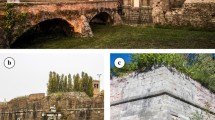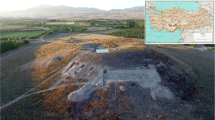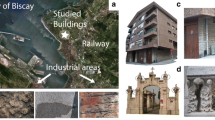Abstract
Background, aim and scope
The external surface of any building in urban polluted environment is unavoidably destined to be covered with layers that assume a grey to black colour and are generally called ‘black crusts’. These, according to standard protocols and glossary, are deteriorated surface layers of stone material; they can have variable thickness, are hard and fragile and can detach spontaneously from the substrate, which, in general, is quite decayed. Plain visual examination may lead to consider ‘black crusts’ all similar, whilst only a careful diagnostic investigation can distinguish ‘black crusts’ and the consequences of their formation on stone substrates. In this paper, various black layers on marble are studied and compared and the morphological and compositional characteristics discussed according to the related mechanisms of formation. Differences between old (hundred years) and recent crusts (30 years) are investigated and pointed out.
Materials and methods
Samples of black crusts collected from the Milan Cathedral façade (Candoglia Marble) have been studied and compared with the careful and synergic employ of traditional techniques: optical (transmission and reflected VIS light) and electron microscopy, X-ray spectrometry and micro-Fourier transform infrared spectroscopy.
Results
Visual examination of loose fragments does not allow to point out outstanding differences amongst the various samples; black layers have similar main mineral components, gypsum and airborne particles, with different spatial distribution. The microscopic studies allowed to point out the porosity differences, the gypsum crystallisation habit, different amount of embedded particles, level and progress of marble decay.
Discussion
The observations lead to define three main types of black crusts: black crust deriving from marble sulphation, compact deposit and encrustation due to exogenic materials deposition. Black crusts show evidence of sulphation in progress, without a clear continuity solution between crust and marble; the lack of separation is particularly evident in ‘recent’ crust, where the sulphation process is more active. Black compact deposits show a higher porosity than black crusts because gypsum is not coming from the chemical corrosion of the substrate but from outside; actually, in the former case, the substrate is sound. Encrustations show a highly regular crystal organisation of gypsum (close packed tabular crystals) that cannot be traced back to casual atmospheric deposit or to corrosion of the substrate but rather to the crystallisation of a solution coming from an external source. Also in this case, the marble is sound; evidence of the effect of some protection treatment is pointed out.
Conclusions
In spite of the apparent similarity of the examined samples, analytical results have evidenced three main types of black crusts: black crust with decayed substrate, compact deposit and black encrustation showing a sound substrate underneath. Experimental evidence of calcite grains sulphation in progress, taking place according to a model recently proposed, has been observed. Sulphation process is prevented where particular conservation treatments had been applied in the past.
Recommendations and perspectives
New experimental studies can be focussed to understand the specific conditions (measurements of micro-climatic and thermodynamic parameters) and mechanisms for black crusts formation in situ. The problem of the kinetic of the sulphation process of marble, the assessment of black layers formation in the case of different carbonate stone materials and the study of acid attack in presence of surface protecting layers deserve further investigation.






Similar content being viewed by others
References
Alessandrini G, Realini M, Calia A, Mecchi AM, D’Agostino F, Rizzo G (2002) The old town of Palermo (Italy): stone materials and their decay. Protection and Conservation of the Cultural Heritage of the Mediterranean Cities. In: Galán E, Zezza F (eds) Proceedings of the 5th International Symposium on the Conservation of Monuments in the Mediterranean Basin, Sevilla, Spain, 5–8 April 2000. Swets & Zeitlinger, Lisse, The Netherlands, pp 93–99
Allen GC, El-Turki A, Hallam KR, Coulson EE, Stowell RA (2004) Mechanisms of attack on limestone by NO2 and SO2, stone decay—its causes and controls. In: Smith BJ, Turkington AV (eds) Proceedings of Weathering 2000—an International Symposium held in Belfast, 26–30 June 2000. Donhead, Shaftesbury, pp 75–88
Amoroso GG, Fassina V (1983) Stone decay and conservation. Atmospheric pollution, cleaning, consolidation and protection. Elsevier, Amsterdam
Ausset P, Del Monte M, Lefèvre RA (1999) Embryonic sulphated black crusts on carbonate rocks in atmospheric simulation chamber and in the field: role of carbonaceous fly-ash. Atmos Environ 33:1525–1534
Ausset P, Lefèvre RA, Del Monte M (2000) Early mechanisms of development of sulphated black crusts on carbonate stone. In: Fassina V (ed) 9th International Congress on Deterioration and Conservation of Stone, Venice, Italy, 19–24 June 2000. Elsevier, Amsterdam, pp 329–337
Böke H, Götkurk H, Caner Saltik EN, Demirci Ş (1999) Effect of airborne particle on SO2-calcite reaction. Appl Surf Sci 140:70–82
Brimblecombe P (1992) A brief history of grime: accumulation and removal of soot deposits on buildings since the 17th century. In: Webster RGM (ed) Stone cleaning and the nature, soiling and decay mechanisms of stone. Proceedings of the International Conference, Edinburgh, U.K., 14–16 April 1992. Donhead, London
Bugini R, Laurenzi Tabasso M, Realini M (2000) Rate of formation of black crusts on marble. A case study. J Cult Herit 1:111–116
Camisasca O (1941) Il marmo di Candoglia e i suoi minerali. Atti Soc Ital Sc Nat 80(2):199–222
Camuffo D, Del Monte M, Sabbioni C (1983) Origin and growth mechanisms of the sulfated crusts on urban limestone. Water Air Soil Poll 19:351–359
Cattanei A (1993) Intorno al trattamento delle pietre: i derivati inorganici del silicio (1818–1979). ANAΓKH 2:26–34
Chapoulie R, Cazenave S, Duttine M (2008) Laser cleaning of historical limestone buildings in Bordeaux. Appraisal using cathodoluminescence and electron paramagnetic resonance. Environ Sci Pollut Res Int 15(3):237–243
Charola AE, Ware R (2002) Acid deposition and the deterioration of stone: a brief review of a broad topic. In: Siegesmund S, Weiss T, Vollbrecht A (eds). Natural stone, weathering phenomena, conservation strategies and case studies, vol 205. Geological Society, London, pp 329–345
Del Monte M, Furlan V (1995) Croûtes noires, sulfatation ed degradation de la pierre. Conservation et restauration des biens culturels. In: Pancella R (ed) Actes du Congrès LCP 1995, Montreux, Switzerland, 24–29 Septembre 1995. EPFL, Lausanne, pp 349–369
Elfving P, Panas I, Lindqvist O (1994) Model study of the first steps in the deterioration of calcareous stone: I. Initial surface sulphite formation on calcite. Appl Surf Sci 74:91–98
Esbert RM, Díaz-Pache F, Grossi CM, Alonso FJ, Ordaz J (2001) Airborne particulate matter around the Cathedral of Burgos (Castilla y León, Spain). Atmos Environ 35:441–452
Fitzner B, Heinrichs K (2002) Damage diagnosis on stone monuments—weathering forms, damage categories and damage indices. In: Prikryl R, Viles HA (eds) Understanding and managing stone decay. Proceeding of the International Conference ‘Stone weathering and atmospheric pollution network (SWAPNET 2001)’, 11–56, Charles University in Prague. Karolinum, Prague
Garcia-Vallés M, Blázquez F, Molera J, Vendrell-Saz M (1996) Studies of patinas and decay mechanisms leading to the restoration of Santa Maria de Montblanc (Catalonia, Spain). Stud Conserv 41:1–8
Gauri KL, Gwinn JA (1982/1983) Deterioration of marble in air containing 5–10 ppm SO2 and NO2. Dur Build Mat 1:217–223
Grossi CM, Esbert RM, Díaz-Pache F, Alonso FJ (2003) Soiling of building stones in urban environments. Build Environ 38:147–159
Hamilton RS, Revitt DM, Vincent KJ, Butlin RN (1995) Sulphur and nitrogen particulate pollutant deposition on to building surfaces. Sci Total Environ 167:57–66
Hutchinson AJ, Johnson JB, Thompson GE, Wood GC (1992) The role of fly-ash particulate material and oxide catalysts in stone degradation. Atmos Environ A26:2795–2803
Johansson LG, Lindqvist O, Mangio RE (1988) Corrosion of calcareous stones in humid air containing SO2 and NO2. Dur Build Mat 5:439–449
Lefèvre RA, Ausset P (2002) Atmospheric pollution and building materials: stone and glass. In: Siegesmund S, Weiss T, Vollbrecht A (eds) Natural stone, weathering phenomena, conservation stategies and case studies, vol 205. Geological Society, London, pp 329–345
Malaga-Starzec K, Panas I, Lindqvist O (2004) Model study of initial adsorption of SO2 on calcite and dolomite. Appl Surf Sci 222:82–88
Maravelaki-Kalaitzaki P, Biscontin G (1999) Origin, characteristics and morphology of weathering crusts on Istria stone in Venice. Atmos Environ 33:1699–1709
Maravelaki-Kalaitzaki P, Bertoncello R, Biscontin G (2002) Evaluation of the initial weathering rate of Istria stone exposed to rain action, in Venice, with X-ray photoelectron spectroscopy. J Cult Herit 3:273–282
Moropoulou A, Bisbikou K, Van Grieken R, Zezza F, Macri F (1998) Origin and growth of weathering crusts on ancient marbles in industrial atmosphere. Atmos Environ 32:967–982
Papageorgakis J (1961) Marmore und kalksilicatfelse der zone Ivrea-Verbano zwischen Ascona und Candoglia. Schwetz Miner Petr Mitt 41:157–254
Rosvall J (1988) Air pollution and conservation. Dur Build Mat 5:209–237
Saiz-Jimenez C, Hermosin B (2004) Black crusts in the European built environment. Corros Rev 22(5–6):381–393
Siegesmund S, Torok A, Hupers A, Muller C, Klemm W (2007) Mineralogical, geochemical and microfabric evidences of gypsum crusts: a case study from Budapest. Environ Geol 52(2):369–381
Vergès-Belmin V (1994) Pseudomorphism of gypsum after calcite, a new textural feature accounting for the marble sulphation mechanism. Atmos Environ 28:295–304
VVAA (1997) Saving our architectural heritage: the conservation of historic stone structures. In: Baer NS, Snethlage R (eds). John Wiley, Chichester
Author information
Authors and Affiliations
Corresponding author
Additional information
Responsible editor: Alvin L. Young
Rights and permissions
About this article
Cite this article
Toniolo, L., Zerbi, C.M. & Bugini, R. Black layers on historical architecture. Environ Sci Pollut Res 16, 218–226 (2009). https://doi.org/10.1007/s11356-008-0046-8
Received:
Accepted:
Published:
Issue Date:
DOI: https://doi.org/10.1007/s11356-008-0046-8




